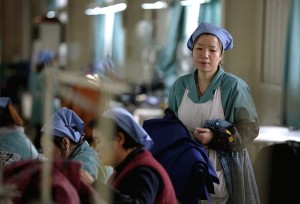China manufacturing shrinks in January—govt

Women work at a garment factory in Huaibei in central China’s Anhui province Tuesday, Jan. 20, 2015. AP FILE PHOTO
BEIJING, China – China’s manufacturing activity contracted for the first time in more than two years in January, an official survey showed Sunday, signaling further downward pressure on the world’s second-largest economy.
The official Purchasing Managers’ Index (PMI) released by the National Bureau of Statistics (NBS) came in at 49.8 last month, down from 50.1 recorded in December.
The index, which tracks activity in factories and workshops, is considered a key indicator of the health of China’s economy, a major driver of global growth. A figure above 50 signals expansion, while anything below indicates contraction.
January’s figure was the first contraction for 27 months.
British banking giant HSBC said last month that a preliminary reading of its own PMI edged up to 49.8 in January from a final reading of 49.6 in December. It was at the break-even point of 50.0 in November.
Article continues after this advertisementThe bank is scheduled to release its final PMI figure on Monday.
Article continues after this advertisementANZ Banking Group said in a research report that the NBS figures were unexpected, particularly given “favorable seasonal factors”.
“The Chinese New Year falls into late February this year, while it was in late January last year,” ANZ said.
“Past experience suggests that there could be significant front loading effect before the Chinese New Year, which would provide short-term impetus to the manufacturing industry.”
China’s central bank surprised economists in November by cutting benchmark interest rates for the first time in more than two years, in a move interpreted as an attempt to shore up flagging growth.
The People’s Bank of China lowered its one-year rate for deposits by 25 basis points to 2.75 percent and its one-year lending rate by 40 basis points to 5.6 percent.
The Chinese economy is struggling with not just stalling factory growth, but also other problems including soft exports and the weakening property market.
It grew 7.4 percent in 2014, slower than the 7.7 percent in 2013 and the worst since the 3.8 percent recorded in 1990.
Authorities had for months used various kinds of limited stimulatory measures such as targeted cuts in bank reserve requirements — aimed at freeing up funds for lending — and a cash injection into the country’s five biggest banks for re-lending.
But top leaders say they are ready to tolerate slower expansion and will avoid aggressive measures to boost growth as the government seeks to shift the economy away from its dependence on investment and exports towards more sustainable consumer-driven growth.
Premier Li Keqiang said last month at the World Economic Forum in Davos that he was determined to bring changes that would deliver “quality growth” rather than just a high top-line figure.
RELATED STORIES
China’s economy not headed for ‘hard landing’—PM